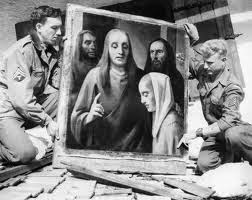Han Van Meegeren (1899-1947) got to be famous around The Hague’s high
society as a portrait painter, but his style grew out of date and the critics
around his artwork were terrible. As a kind of revenge, in 1992 he starts
forging great Dutch masters’ works, especially Vermeer’s: an artist he doesn’t
know much about and that had been rediscovered around 1866. Only 36 paintings
of his are assured to have been painted actually by him.
 |
| Han van Meegeren (Wikipedia) |
He imagined compositions copying Vermeer’s ways of painting and then
he would add a copy of his signature. He also discovered a way to make his
forgeries seem to be originary from XVII century. He would adquire works of
Vermeer’s time, get rid of the original painting, obtain those pigments used by
then on his own, make his own brushes… but getting an artwork to seem 300 years
old isn’t an easy task. After several tests, he reaches to the perfect formula:
that was adding bakelite, a kind of plastic, to the pigments and disolving the
mixture in turpentine; afterwards, he would bake the canvas for 2 hours with a
heat of 248ºF.
That way, he made the oils be as hard as the ones of Vermeer’s
paintings would be. But he would also have to imitate the craquelure that oils provoke
as time passes. To achieve that, he would apply a layer of varnish and crack it
manually afterwards in irregular shapes, repeating this procedure a couple of
times before adding some dirt into the cracks and covering them with black ink.
The themes of the forgeries were mainly religious, and that was
totally intended: in 1901 ‘Christ in the
House of Martha and Mary’ appeared, actually painted by Vermeer, but this
one seemed kind of unfitting among the rest of his works. It was like van
Meegeren was filling the gaps in Vermeer’s artwork. Van Meegeren’s masterpiece
was ‘Supper at Emaus’ (1936). He
almost deceived all of the critics, among them, the director of Rotterdam
Museum, which he bought the painting for[1].
Ever since this achievement, he started being less careful with his
procedures. He painted 6 forgeries in 6 years and got paid an equivalent of 32
million dollars.
In 1943, Göring gets to know the appearance of a new Vermeer: ‘Christ with the Adulteress’. He knew
that there was no work by Veermer among the ones in his huge art collection,
all obtained in spoils of wars and bought for himself using public funds.
 |
| Van Meegeren, Christ with the Adulteress |
Hitler had already been 2 times faster than him and he just couldn’t
waste this chance. Through an intermediary, since van Meegeren never appeared
in middle of the
deals, sends it to Göring, who wasn’t convinced to buy it for it’s
high price (10 million dollars), and he keeps it home for a couple of weeks. He
finally exchanges it for 137 other paintings he had in his collection, after
that, the intermediary starts to mistrust and abandons the negotiations, so van
Meegeren and Göring would have to negotiate personally.
In April 1945, war ended and Göring and he orders the evacuation of
his whole collection, he tries to escape, yet, he got arrested by American. The
collection is recovered by the Allies and is sent to Munich, so that the
paintings in it are sent to their owners.
In Netherlands, a policeman called Piller chases those who supported
the regime and van Meegeren shows up in Göring’s inventories. He was living in
a palace, in an endless chain of parties, spending the huge amount of money he
had got. Nobody in Netherlands could afford such expenses during the war. He claimed to have won the lottery twice, but
Piller arrests him for supposed collaboration, which would lead him to be
condemned to death. During the interrogations, he asks for patience and says:
Idiots! You believe that I sold
a Vermeer to the fat of Göring, but the painting is not a Vermeer at all: I
painted it myself!
Due to this confession, Piller finds himself in front of another
dilemma: if van Meegeren was telling the truth, he couldn’t be condemned for
collaborating with the regime, just for deceiving a nazi and fraud, which would
mean serving 4 years in jail. But first, they would have to confirm this
theory, so Piller locks him up in a room with witnesses and makes him paint
another ‘Vermeer’. On 29th October 1945, the trial is held and van Meegeren is
only condemned to serve 1 year in jail. But he died before due to a heart
attack and died in a hospital on 30th December 1945. During a casual
conversation in jail in 1946, Göring gets to know that his beloved ‘Christ with the Adulteress’ was
actually painted by van Meegeren. Shocked and full in anger, he reacted this
way:
No, no, no! That’s impossible!
The painting was old, so old that I had to send it to restoration! That would
be an enormous fraud since that is the painting I most have ever paid for!
cristinadelrosso.com // cristinadelrosso.artproject@gmail.com
Sources: Dolnick, E. Der
Nazi und der Kunstfälscher. Berlín, Parthas, 2014
López, J. Man who made
Vermeers. Boston, HMH, 2009
Translation: C.del Rosso and L. Vigo
Share if you like, and don't forget to comment on the comment zone!



No comments:
Post a Comment